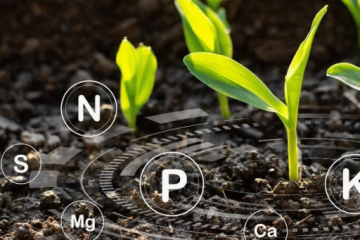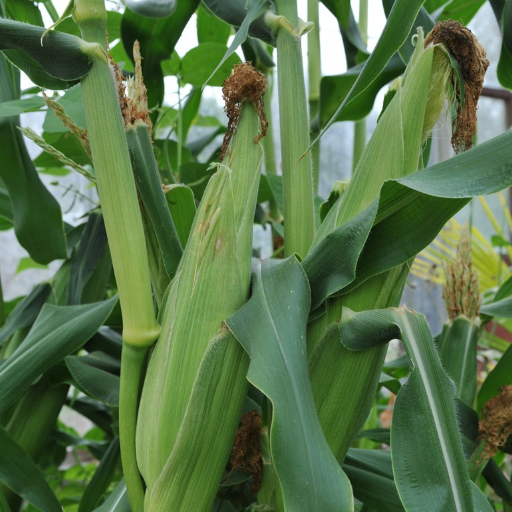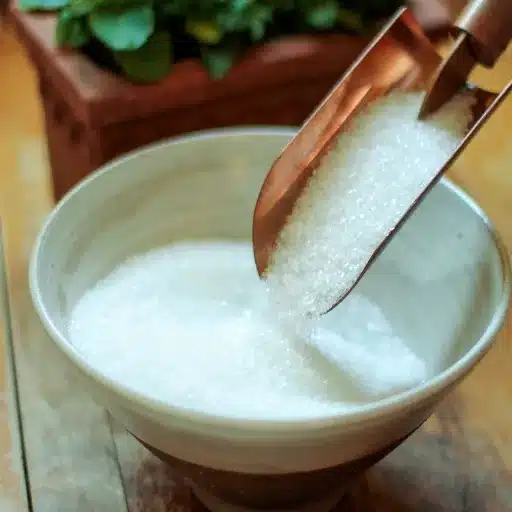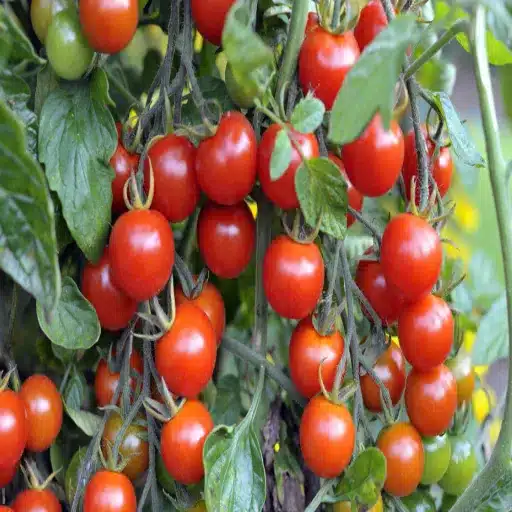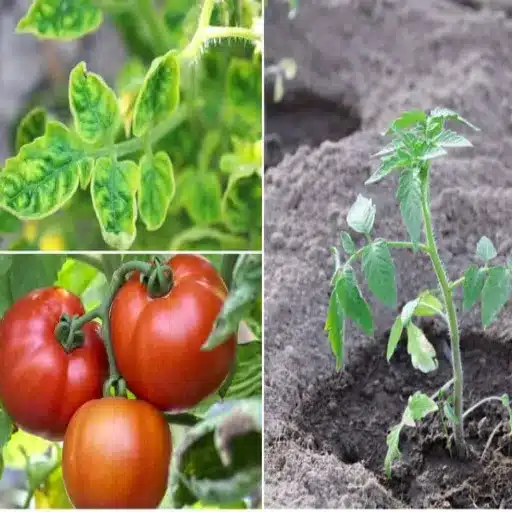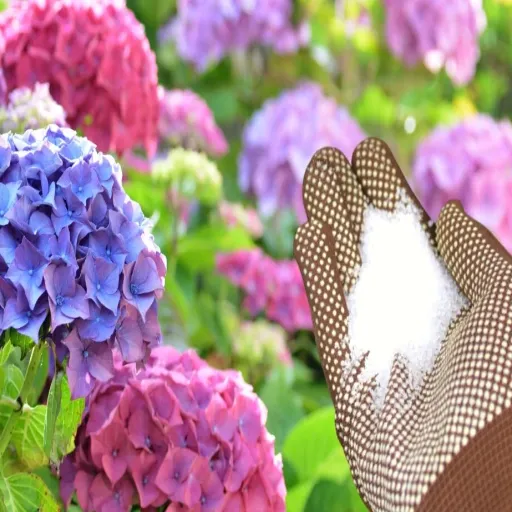Corn is one of the most widely cultivated crops in the world, playing a crucial role in global agriculture and food supply systems. However, achieving optimal corn production isn’t just about planting seeds and waiting for growth—soil health and plant nutrition are critical. Among the variety of nutrients required for healthy corn development, magnesium stands out as an essential element responsible for photosynthesis, enzyme activation, and overall plant vitality. This article explores how Epsom salt can be used to enhance corn yields. Whether you’re an experienced farmer or a home gardener, understanding the science behind Epsom salt’s role in plant growth could revolutionize your approach to corn cultivation.
Identifying Magnesium Deficiency in Corn Plants
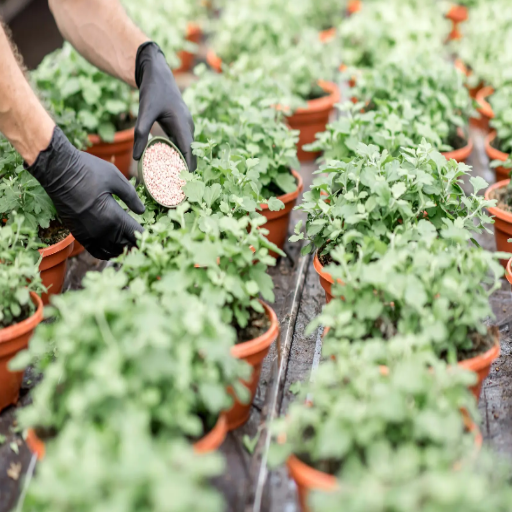
Recognizing Interveinal Chlorosis and Yellow Leaves
The magnesium deficiency of corn and other monocots is associated with interveinal chlorosis, which describes leaves with yellow, stricken tissue between green veins. This condition is usually seen with older lower leaves first due to magnesium being a mobile nutrient within the plant. The plant extracts magnesium from the older parts of the plant to help in new growth. The chlorosis starts from the edges of the leaf towards the center of the leaf and worsens as the chlorosis gets more severe. Leaving these symptoms unchecked can cause damage to the plants by reducing chlorophyll production, which, as an internal effect,t inhibits photosynthesis and creates a risk to the plant’s health.
The deficiency of magnesium in soils is mostly linked to unbalanced or depleted nutrients. Soils that are high in calcium or potassium often limit magnesium, as these types of soils tend to compete for zinc. Potassium may be allowed through the plant root regions. For sandy soils, those soils that are made up of low organic sand tend to have less ability to retain magnesium, making them vulnerable to this condition. These matters may worsen due to acidic conditions in the soil, as magnesium tends to leach off more readily in these environments.
Warding off the effects of magnesium deficiency requires crucial magnesium interventions that are best addressed promptly. Using Epsom Salt or magnesium sulfate, as a foliar spray or soil treatment, aids in relieving magnesium deficiency. Bypassing the difficulties of soil magnesium uptake, foliar applications enable plants to absorb magnesium through the leaves. Precision approaches alongside constant tracking can avert yield loss and stunted crop advancement. Magnesium sufficiency enhances the ability of corn plants to perform photosynthesis and support development and productivity optimally. Enhanced magnesium levels allow corn plants to perform photosynthesis more effectively, thereby supporting their growth and productivity maximally.
Magnesium Deficiency Symptoms Throughout Growth Stages
The lack of magnesium in a corn plant may show at different stages of the plant’s growth, often showing signs unique to the deficiency severity and timing. At the early vegetative stage, the symptoms show as interveinal chlorosis on the older leaves, where the veins remain green while the area in between turns yellowish pale. This happens due to magnesium being a mobile nutrient because it enables the plant to transport to newer growth when the supply is deficient.
In the mid-growth stages, there could be some increase in the intensity of chlorosis, developing into older necrotic spots due to prolonged deficiency. In addition, the older leaves are likely to shatter. These symptoms become worse for the plants that have low cation exchange capacity in the soil and high potassium levels, which can antagonize magnesium uptake. At this stage, the plant is essential for biomass accumulation, which is further reduced by the emerging symptoms with a faint CEC value soil.
At the reproductive stages, magnesium deficiency can stunt grain development or diminish kernel weight because of inadequate carbohydrate translocation. Kernels within an ear may fill unevenly, or there may be gaps within the rows, greatly affecting yield potential. Tissue testing and equitable monitoring during these growth phases are critical to correctly diagnose magnesium deficiency, and magnesium adequacy ensures plant performance and improved productivity.
How to Apply Epsom Salt to Corn Plants Effectively

Foliar Application Methods and Timing
Due to the capability of foliar application to deliver nutrients directly to plant tissues, the application of Epsom salt (magnesium sulfate) solves magnesium deficiencies in corn plants efficiently. This method enables Epsom salt to be applied through a solution that can be absorbed better if sprayers are used in the early morning or late evening. This helps minimize evaporation, allowing the solution to stay on the leaf’s surface longer and facilitating better nutrient uptake.
To facilitate better results, solve 1 to 2 pounds of Epsom salt in 10 gallons of water for every acre being treated. It is critical not to use more than 2 pounds as this can result in unwanted accumulation. Ensuring each plant is covered using a well-calibrated sprayer will help achieve full foliage coverage. Applications need to align with essential growth stages as magnesium support during the photosynthesis phase is crucial. Secondary application during the early phase of ear formation improves kernel fill and overall crop yield.
Keeping track of environmental conditions before applying anything is essential. Ensure the temperature is neither too hot nor too cold, as this will help prevent leaf scorch and ensure consistent coverage. Epsom salt foliar sprays combined with appropriate nutrients or growth regulators can improve plant physiological functions, though testing for compatibility is important because untested mixtures may lead to suboptimal results. Periodic tissue testing following application can validate magnesium and help adjust future treatments, which aids in consistent productivity.
Soil Application Rates for Different Growth Stages
Collection rates for soil applications of magnesium differ with respect to the growth stage of the plant and the crop itself. During the early vegetative stage applying, twenty to forty pounds of magnesium sulfate per acre is known to support root development thereby ensuring proper nutrient uptake. Magnesium application is known to bolster growth while guaranteeing that nutrient deficiency is avoided at the onset.
During the flowering or reproductive stage, magnesium usage is often noted to increase severely owing to its necessity during photosynthesis and carbohydrate metabolism. During this growth phase, supplemental application of magnesium sulfate at fifteen to twenty-five pounds of magnesium sulfate per acre is advised. Split application during this phase is the best aid to ward off toxicity risk.
For crops that are nearing the maturity stage, aiming to achieve magnesium deficiency at ten to fifteen pounds per acres helps avert physiological disorder towards the later stages while enhancing crop quality. Constant monitoring along with precision soil testing as outlined throughout the entire growth cycle allows for the eluding of excessive application.
Using Epsom Salt Early in the Season for Best Results
The natural mineral compound of magnesium sulfate, Epsom salt, can remarkably aid in enhancing development during the early growing season. Since magnesium is more than often a major component in chlorophyll, it is trained to assist with photosynthesis and energy metabolism, while sulfur helps to build up amino acids and proteins. Plants tend to have strong root systems and vigorous vegetative growth early on, meaning that administering Epsom salt during this period helps maximize effectiveness.
To maximize effectiveness of the plants and soil, Epsom salt should be applied around 20 to 30 pounds per acre, where it can be added as either a foliar spray or a soil amendment. Regardless of the crop or soil condition, these parameters will yield optimized results. Research says early season distribution aids in nutrient uptake, especially in areas lacking magnesium, and strengthens plants against the different environmental forces later on.
Other than providing improved crop yield, field tests of Epsom salt suggest that when it is being strategically used through complete nutrient management, it helps sustain healthy plant foliage while giving special attention to the primary fertilizers being used. To maintain strategic and sustainable practices, growers can achieve bountiful harvests of better quality yield in the end.
Can Epsom Salt Harm Corn Plants?

When Epsom Salt May Not Be Beneficial
Although Epsom salt can boost certain conditions for plant growth, in other cases, like with corn plants, its application may prove detrimental. Overuse of magnesium sulfate, for instance, can disrupt the nutrient balance of soil. Corn, like most other plants, is highly dependent on key macronutrients, especially nitrogen (N), phosphorus (P), and potassium (K). When Epsom salt is applied in excess, the surplus magnesium it contains can hinder the uptake of these vital nutrients and thus impede growth while degrading yield quality.
Concerning factors also include the level of magnesium present in the soil. Using Epsom salt on soils that are already high in magnesium may create toxic levels that damage root systems as well as plant health. To prevent any negative outcome, soil testing needs to be conducted before application. This will avoid using Epsom salt in a manner that disrupts the existing nutrient profile of the soil.
Contained salt increases the nominal stress on plants by creating a barrier on the roots, preventing water absorption, especially during stress. Also, the emphasis on other soil minerals is minimized could demonstrate the benefits of foundation alterations. All minerals and compounds, even in an oversupplier domain, necessitate precise coordination for full benefits, such as favorable agricultural results.
The Importance of Soil Test Results Before Application
Soil analysis is extremely important for maintaining one’s crop yields since understanding the results of a soil test is key to maintaining a farmer’s soil health and utilizing their land in the best way possible. Testing your soil is akin to having a health checkup for your soil, as it diagnoses the levels of nutrients, balance of pH, organic matter magnitude, and other various physical and chemical elements that the soil contains. The information that is gathered in a soil test is critical for determining application rates of fertilizers, potential nutrient imbalance correction, or addressing deficits before these factors interfere with crop yield.
Farmers striving to improve crop yields without a soil test run the risk of nutrient over- or underapplication, which can result in poor harvests, soil erosion, or adding more than required nutrients, which risks an imbalance, wreaking havoc on the ecosystem. The soil testing methods now incorporate the analysis of macronutrients like nitrogen, phosphorus, calcium, and potassium, coupled with micronutrients zinc, copper, and manganese, ensuring their focus is on nurturing plants’ growth in the best way possible.
In addition, contemporary technologies and modern data tools provide for accurate mapping of soil conditions in various parts of a field enabling precision site specific applications which minimize waste. Adoption of these practices not only improves farming operations but also improves resource efficiency and ensures enduring soil health.
Epsom Salt vs. Other Fertilizers for Corn Production

How Magnesium Interacts with Nitrogen and Phosphorus
As a magnesium metalloid, it affects nutrient use efficiency improvement by being a core component of chlorophyll that takes part in photosynthesis. This step, in turn, affects the uptake and assimilation of nitrogen. It is known that magnesium aids in the reduction of nitrates to amino acids, which are the constituents of plant proteins. Magnesium also enhances the usefulness of phosphorus in the plant by helping in the transfer of energy via ATP (adenosine triphosphate), which serves in root formation and seed development.
Magnesium deficiency restricts the effectiveness of nitrogen and phosphorus fertilizers, which causes deficient growth and yield reduction. Optimum magnesium levels in soil increase the efficiency of nitrogen utilization due to bound enzymatic activities required for the metabolism of nitrogen. In the same manner, energy-dependent processes required for the transport of phosphorus in plant tissues are inefficient in magnesium-deficient conditions, resulting in slowed uptake of Phosphorus.
Correcting these deficiencies can be achieved by using magnesium-rich supplements like Epsom salt (magnesium sulphate), which can be incorporated into the fertilization programs. It is also known that Epsom salt is soluble and readily available compared to other magnesium sources, making it more useful during the later stages of growth.
To achieve maximum plant productivity and crop quality, advanced nutrient management strategies should consider the mutual interactions of magnesium with soil and nitrogen as well as phosphorus synergy.
Balancing Magnesium and Sulfur with Other Nutrients
Nurturing sulfur (S) and magnesium (Mg) alongside other nutrients is crucial in meeting plant growth and developmental milestones. Magnesium is vital for photosynthesis, acting as the heart within the chlorophyll molecules, while sulfur represents an important part in many of the fundamental building blocks of life, like enzymes and amino acids. On the other hand, neglecting any of these key nutrients, about calcium (Ca), nitrogen (N), and potassium (K), may lead to imbalances that affect crop quality and yield performance suboptimally.
An unfettered supply of nitrogen results in interveinal chlorosis of crops due to magnesium deficiency occurring from a lack of addressing magnesium demand. Other causes include high levels of potassium competing for magnesium intake, ionic competition, and low cation exchange capacity soils. At best, soils with low cation levels take the brunt of domineering high levels of potassium. These facts alone justify reliance on soil tests and tailored fertilizer schemes for nutrient balance.
In Addition, when it comes to adding sulfur, it must be considered that it will also affect phosphorus (P) uptake. Sulfur contributes to root development, which should improve phosphorus uptake; however, too much sulfur may overacidify the soil and reduce the availability of some essential micronutrients. Hence, the design of an integrated nutrient management plan using precision agriculture tools can more effectively manage magnesium and sulfur balance with other important macro and micronutrients to improve crop productivity and sustainability.
Common Questions About Using Epsom Salts in the Garden

Will Epsom Salt Make Corn Leaves Turn Red?
The corn leaves turning red signal a deficiency in nutrients, and more specifically in phosphorus, rather than being a direct effect of the use of Epsom salt. The use of Epsom salt, or magnesium sulfate, provides magnesium and sulfur, but does not supply enough nutrients essential for the plant to alter the anthocyanin-red pigment accumulating in the leaves.
The most common cause of red aphresis or red-amphora for red-tinted leaves in corn is phosphorus deficiency. This condition is developed due to a lack of phosphorus, which can result from cold soil temperature or improper pH levels. Yet, Epsom salts have the potential to indirectly induce plant stress if they are overused together with carbonate soils that are high in magnesium. High levels of magnesium can excessively cause problems by inhibiting the uptake of other essential nutrients like potassium and calcium, which can worsen nutrient imbalances.
To diminish the effects of red leaves on the corn crop, growers need to ensure that the soil test results comply with the set goals defined by the nutrient deficiency objectives and phosphorus adequacy primed goals. In combination with results along with proactive and reactive fertilization phas techniques functioning on controlling soil along with optimal pH levels, nutrient-shortages erosion enabling suppression of the allergenic plethora of red leaves.
How Soil pH Affects Magnesium Availability to Plants
An important macronutrient that supports plant development, Magnesium is imperative for chlorophyll formation and other enzymatic functions. However, its availability is largely determined by the soil pH. Research shows magnesium absorption is severely restricted to acidic soils with a pH below 5.5 due to increased leaching and fixation into non-plant usable forms. Acidic conditions usually contain higher concentrations of competing ions, like aluminum and hydrogen, that further drive down the magnesium absorption rate.
On the other hand, in highly alkaline soils above pH 8.0, the precipitation of soluble magnesium carbonate can lower magnesium solubility. Magnesium is most abundant when the soil pH is between 6.0 to 7.5, since at that range the conditions are ideal for sufficient solubility and minimal competition from other cations.
To remedy the problem of pH related magnesium inadequacy, using magnesium containing lime (dolomitic lime) in acidic soils and periodic checks of soil pH to inhibit windows of low nutrient availability are suggested. These strategies guarantee adequate magnesium levels which, in turn, will bolster plant growth and yield crops.
References
Frequently Asked Questions (FAQs)
Q: Why do plants need magnesium, and how does it affect corn growth?
A: Magnesium is essential for plant growth, particularly in corn. It’s a core component of chlorophyll, which plants need for photosynthesis. When corn is Mg deficient, you’ll notice the lower corn leaves turn yellow, often starting at the leaf tips and progressing inward, while the veins remain green. Magnesium deficiency can lead to smaller plants, poor tassel development, and reduced yield. In severe cases, corn leaves may turn red or purple. Ensuring proper magnesium levels in the plant supports healthy growth, strong stalks, and optimal grain production.
Q: How can I tell if my corn is Mg deficient and needs supplementation?
A: Corn that is Mg deficient typically shows symptoms in the older, lower leaves first. The classic sign is interveinal chlorosis – yellowing between the leaf veins while the veins remain green. In advanced stages, the entire corn seedling might exhibit stunted growth, and leaves may develop reddish-purple coloration at the edges. To properly determine mg levels in your soil, conduct a soil test before planting season. Tissue testing during the growing season can help measure mg levels in the plant directly. If your soil pH is less than 6.0, magnesium is often less available to the plant, even if present in the soil.
Q: Will epsom salt kill my corn plants if used incorrectly?
A: Yes, epsom salt can kill corn plants if applied excessively. While epsom salt (magnesium sulfate) is generally good for plants when used appropriately, over-application can disrupt nutrient balance in the soil and prevent other essential nutrients from being absorbed. To avoid damage, follow recommended application rates – typically 1-2 tablespoons per gallon of water for foliar spray or 1 cup per 100 square feet when incorporated into soil. Never apply epsom salt to already stressed plants, during hot midday sun, or when plants are suffering from drought stress. Always start with lower concentrations and monitor your plants’ response.
Q: How should I apply epsom salt for plants, specifically corn?
A: There are several effective methods for applying epsom salt for plants like corn. For soil application, mix 1 cup of epsom salt per 100 square feet and incorporate it into the soil before planting. For established corn, sidedress by applying 1-2 tablespoons per plant around the base, keeping it a few inches away from the stalks. Foliar application is highly effective – mix 1-2 tablespoons per gallon of water and spray directly onto leaves, focusing on complete coverage, including the top of the plant. For best results, apply in the early morning or evening when temperatures are cooler. When using as a foliar spray, add a few drops of mild dish soap to help the solution stick to the leaves.
Q: What’s the best water ratio when using epsom salt for corn?
A: The ideal water ratio when using epsom salt for corn is generally 1-2 tablespoons of epsom salt per gallon of water for foliar applications. For soil drenches, you can use a slightly stronger solution of 2-3 tablespoons per gallon. When adding epsom to irrigation systems, aim for about 10 pounds per acre. The concentration should be adjusted based on the severity of magnesium deficiency – use the lower concentration for maintenance and the higher concentration when plants show symptoms of deficiency. Always start with the lower concentration and observe the plant’s response before increasing the strength. For young corn seedlings, use the more diluted solution to avoid potential salt stress.
Q: How does epsom salt work as a source of magnesium for corn?
A: Epsom salt (magnesium sulfate) works effectively as a source of magnesium because it dissolves readily in water, making the magnesium immediately available to the plant through either root uptake or leaf absorption. Unlike some other magnesium sources, epsom salt doesn’t alter soil pH. When applied to corn, the plant absorbs the magnesium, which then becomes incorporated into chlorophyll molecules at the top of the plant where active growth occurs. The sulfate component also provides sulfur, another essential nutrient. Magnesium in corn is crucial for enzyme activities, phosphorus metabolism, and protein synthesis. The rapid availability of magnesium from epsom salt makes it especially useful for addressing deficiencies quickly during critical growth stages.
Q: When is the best time to supply Mg before planting corn?
A: The optimal time to supply mg before planting corn is 2-4 weeks before seeding. This timing allows the magnesium to distribute through the soil and become available to the plant immediately upon germination. Fall application is also effective, especially in heavier soils where nutrients move more slowly. When preparing your soil, incorporate epsom salt at a rate of about 1-2 pounds per 100 square feet or 20-40 pounds per acre, adjusting based on soil test results. If your soil pH is less than 6.0, consider using dolomitic lime instead of epsom salt, as it provides both magnesium and helps raise soil pH to improve overall nutrient availability. For best results, combine pre-planting application with a comprehensive soil amendment program based on soil test recommendations.
Q: Can epsom salt correct corn leaves that turn red or purple?
A: Yes, epsom salt can help correct corn leaves that turn red or purple when this discoloration is caused by magnesium deficiency. However, it’s important to note that reddish-purple coloration in corn leaves can also indicate phosphorus deficiency or genetic anthocyanin expression, especially in cold conditions. Before applying epsom salt, confirm that magnesium is indeed the limiting factor through soil or tissue testing. If magnesium deficiency is confirmed, a foliar application of epsom salt solution (1-2 tablespoons per gallon of water) can provide quick relief as the magnesium is directly absorbed through the leaves. For longer-term correction, soil applications will help maintain adequate magnesium levels throughout the growing season and prevent the recurrence of symptoms.
Q: How do environmental factors affect how plants grow with epsom salt treatments?
A: Environmental factors significantly influence how corn responds to epsom salt treatments. Temperature plays a crucial role – in cold soils (below 50°F), magnesium uptake is reduced regardless of availability, so epsom salt applications may be less effective early in the season. Moisture levels are equally important; drought conditions limit nutrient absorption, while excessive rainfall can leach magnesium from the soil. Light intensity affects how quickly plants metabolize magnesium in chlorophyll production, with higher light intensity increasing demand. Soil pH dramatically impacts magnesium availability – in acidic soils (pH less than 6.0), aluminum and manganese can become soluble and interfere with magnesium uptake even when epsom salt is applied. Wind and humidity levels affect the efficiency of foliar applications, with calm, humid conditions being optimal for leaf absorption.


